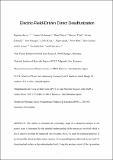Files in this item
Electric-field-driven direct desulfurization
Item metadata
| dc.contributor.author | Borca, Bogdana | |
| dc.contributor.author | Michnowicz, Tomasz | |
| dc.contributor.author | Petuya, Remi | |
| dc.contributor.author | Pristl, Marcel | |
| dc.contributor.author | Schendel, Verena | |
| dc.contributor.author | Pentegov, Ivan | |
| dc.contributor.author | Kraft, Ulrike | |
| dc.contributor.author | Klauk, Hagen | |
| dc.contributor.author | Wahl, Peter | |
| dc.contributor.author | Gutzler, Rico | |
| dc.contributor.author | Arnau, Andres | |
| dc.contributor.author | Schlickum, Uta | |
| dc.contributor.author | Kern, Klaus | |
| dc.date.accessioned | 2018-04-24T23:33:00Z | |
| dc.date.available | 2018-04-24T23:33:00Z | |
| dc.date.issued | 2017-05-23 | |
| dc.identifier | 250199738 | |
| dc.identifier | a5b4affc-9fd2-465b-9f2c-52e7800ba378 | |
| dc.identifier | 85019887779 | |
| dc.identifier | 000402498400035 | |
| dc.identifier.citation | Borca , B , Michnowicz , T , Petuya , R , Pristl , M , Schendel , V , Pentegov , I , Kraft , U , Klauk , H , Wahl , P , Gutzler , R , Arnau , A , Schlickum , U & Kern , K 2017 , ' Electric-field-driven direct desulfurization ' , ACS Nano , vol. 11 , no. 5 , pp. 4703–4709 . https://doi.org/10.1021/acsnano.7b00612 | en |
| dc.identifier.issn | 1936-0851 | |
| dc.identifier.other | ORCID: /0000-0002-8635-1519/work/46939674 | |
| dc.identifier.uri | https://hdl.handle.net/10023/13196 | |
| dc.description.abstract | The ability to elucidate the elementary steps of a chemical reaction at the atomic scale is important for the detailed understanding of the processes involved, which is key to uncover avenues for improved reaction paths. Here, we track the chemical pathway of an irreversible direct desulfurization reaction of tetracenothiophene adsorbed on the Cu(111) closed-packed surface at the submolecular level. Using the precise control of the tip position in a scanning tunneling microscope and the electric field applied across the tunnel junction, the two carbon–sulfur bonds of a thiophene unit are successively cleaved. Comparison of spatially mapped molecular states close to the Fermi level of the metallic substrate acquired at each reaction step with density functional theory calculations reveals the two elementary steps of this reaction mechanism. The first reaction step is activated by an electric field larger than 2 V nm–1, practically in absence of tunneling electrons, opening the thiophene ring and leading to a transient intermediate. Subsequently, at the same threshold electric field and with simultaneous injection of electrons into the molecule, the exergonic detachment of the sulfur atom is triggered. Thus, a stable molecule with a bifurcated end is obtained, which is covalently bound to the metallic surface. The sulfur atom is expelled from the vicinity of the molecule. | |
| dc.format.extent | 962687 | |
| dc.language.iso | eng | |
| dc.relation.ispartof | ACS Nano | en |
| dc.subject | STM | en |
| dc.subject | DFT | en |
| dc.subject | Tetracenothiophene | en |
| dc.subject | Desulfurization | en |
| dc.subject | Electric field | en |
| dc.subject | Single molecules | en |
| dc.subject | QC Physics | en |
| dc.subject | QD Chemistry | en |
| dc.subject | TK Electrical engineering. Electronics Nuclear engineering | en |
| dc.subject | NDAS | en |
| dc.subject.lcc | QC | en |
| dc.subject.lcc | QD | en |
| dc.subject.lcc | TK | en |
| dc.title | Electric-field-driven direct desulfurization | en |
| dc.type | Journal article | en |
| dc.contributor.institution | University of St Andrews. School of Physics and Astronomy | en |
| dc.contributor.institution | University of St Andrews. Condensed Matter Physics | en |
| dc.identifier.doi | 10.1021/acsnano.7b00612 | |
| dc.description.status | Peer reviewed | en |
| dc.date.embargoedUntil | 2018-04-24 |
This item appears in the following Collection(s)
Items in the St Andrews Research Repository are protected by copyright, with all rights reserved, unless otherwise indicated.

